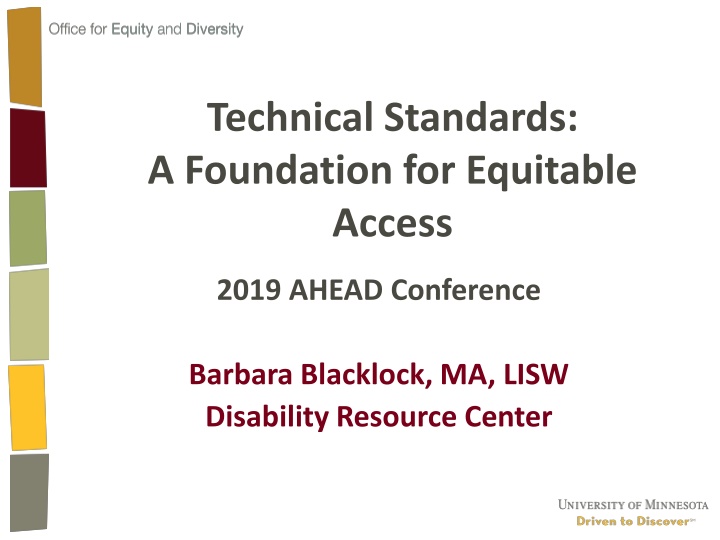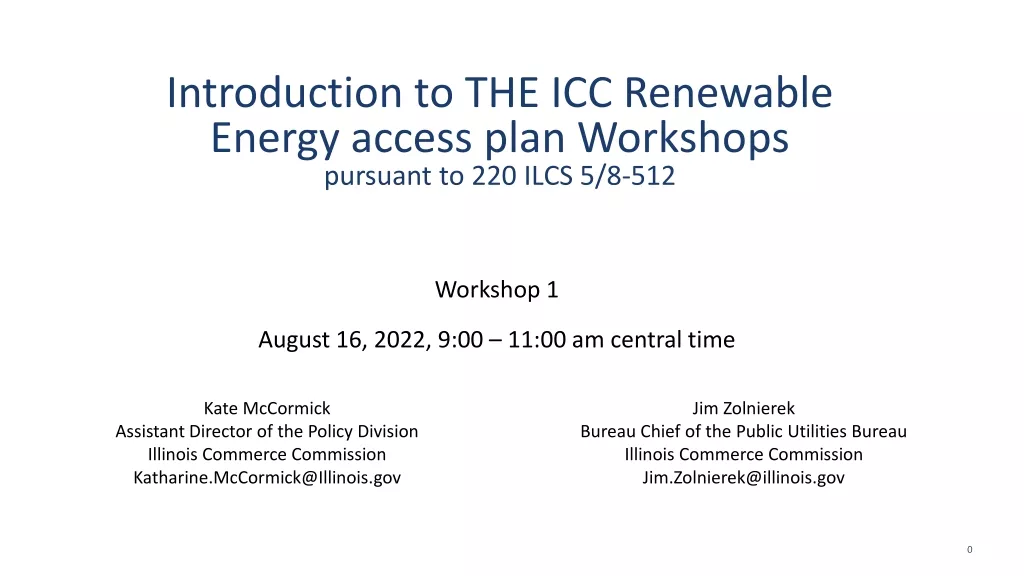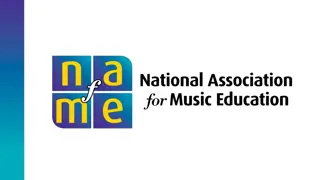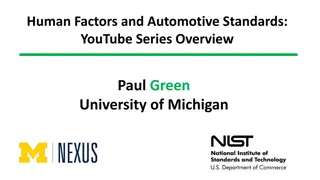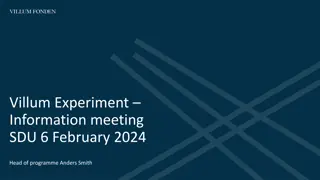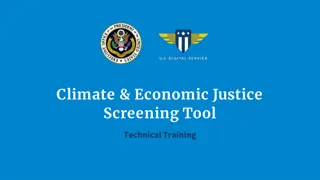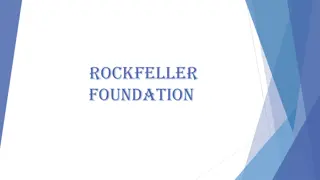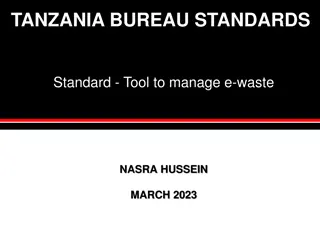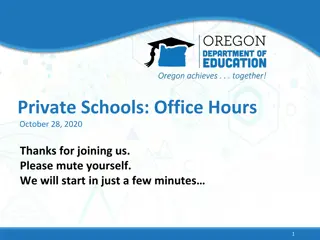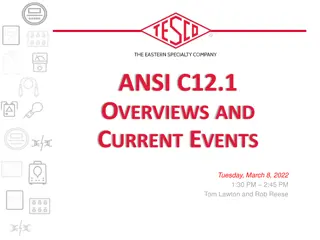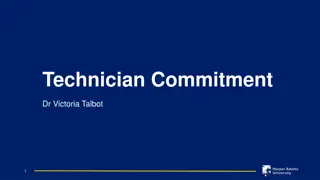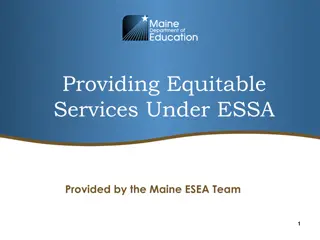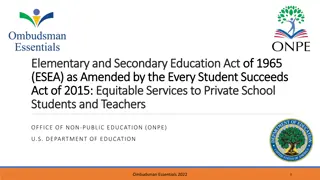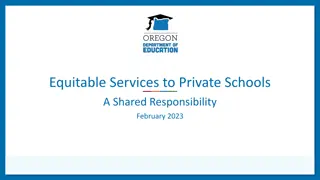Technical Standards: A Foundation for Equitable Access
This presentation delves into the importance of technical standards in ensuring equitable access for individuals with disabilities in academic programs. It covers key areas such as the definition of nonacademic criteria, the history and evolution of technical standards, ADA guidance, and how technical standards can either act as barriers or tools for inclusivity.
Download Presentation

Please find below an Image/Link to download the presentation.
The content on the website is provided AS IS for your information and personal use only. It may not be sold, licensed, or shared on other websites without obtaining consent from the author.If you encounter any issues during the download, it is possible that the publisher has removed the file from their server.
You are allowed to download the files provided on this website for personal or commercial use, subject to the condition that they are used lawfully. All files are the property of their respective owners.
The content on the website is provided AS IS for your information and personal use only. It may not be sold, licensed, or shared on other websites without obtaining consent from the author.
E N D
Presentation Transcript
Technical Standards: A Foundation for Equitable Access 2019 AHEAD Conference Barbara Blacklock, MA, LISW Disability Resource Center
Top Ten Things to Know 1. Definition Nonacademic criteria ( skills, knowledge and ability) essential to participate in the program o Maintained from admission through graduation Five common areas addressed o Observation o Communication o Motor Skills o Cognition o Professionalism Must be met with or without reasonable accommodations
2. History of Technical Standards Term comes from Section 504 of the Rehab Act of 1973 1979 AAMC Defines a qualified individual as one who meets the academic and technical standards requisite to admission or participation in the education program or activity . Recommends 5 key areas for technical standards Intellectual-conceptual, behavior and social, communication, observation, motor capabilities
History of Technical Standards 1990 s licensing agencies began to require technical standards for Academic Health programs 2016 Liaison Committee on Medical Education (LCME) provided guidance that all medical schools have technical standards Technical Standards are not required by law, but may be for program accreditation
3. ADA Guidance Schools shall not impose or apply eligibility criteria that screen out or tend to screen out an individual with a disability or any class of individuals with disabilities unless such criteria can be shown to be necessary for the provision of the service, program, or activity being offered.
4. Technical Standards can be Barriers or Tools Barriers Focus on process Written to exclude those with physical and sensory differences Allow for dismissal of those with differences Inhibits clinical accommodations Limits diversity Tools Focus on outcomes Welcome diversity Support interactive process Promote creative clinical accommodations Identify areas of concern Highlight what is essential Promote due process
5. Technical Standards Differ from Essential Requirements Technical Standard Skills, knowledge and ability, possess and maintain Can get outdated quickly Essential Requirement Specific skills, knowledge and ability need to acquire and demonstrate Course or program specific Used to develop technical standards Often influenced by licensing requirements
Technical Standards Different from Essential Requirements Technical Standard Communication: Candidate must be able to clearly and accurately record information and accurately interpret verbal and nonverbal communication. Essential Requirement Psychiatry Clerkship Students should be able to begin to develop rapport with patients and families, and provide patient and family education, patient advocacy, and demonstrate empathy, caring, and honesty in all patient encounters
6. Functional Standards are Necessary Organic Focus on how task will be performed Suggests only one approach to perform tasks and demonstrate skills Ableist: Excludes those with sensory and physical differences Road block to admission and or progression Functional Focus on outcomes not precise means that must be used Identify task that must be completed. (e.g. move, communicate, assess) Promote exploration of creative accommodations
Quiz Functional or Organic? 1. Must be able to speak, hear and observe patients in order to elicit both verbal and nonverbal information. 2. Must be able to communicate effectively with patients and family, physicians and other members of the health care team. 3. Candidates and students should have sufficient motor function such that they are able to obtain adequate information from a physical examination to provide general care and emergency treatment to patients.
Quiz Functional or Organic? 4. It is required that candidates possess the motor skills necessary to complete and interpret the physical findings of patients. If motor skills are compromised, the candidate must demonstrate alternative means and/or abilities to retrieve these physical findings. 5. Must have sufficient motor function and tactile ability to meet the competencies required for graduation 6. Must be able to clearly and accurately record information
Functional Standards Support Equity
7. Legal Guidance 1979 Southeastern Community College vs Davis Supreme Court, upheld school s TS requiring students to hear. Acknowledged technological advances may change this in future. 2013 McCulley vs University of Kansas School of Medicine Federal court of appeal supported school s TS that required students to have physical strength to lift and perform CPR. Acknowledged another school with different TS may have different outcome
Legal Guidance 2014 Palmer College of Chiropractic s Davenport Civil Rights Commission Supreme Court of Iowa considered whether a student with limited vison could complete a chiropractic training program with the TS, sufficient use of vision, hearing and somatic sensation to perform chiropractic and general physical exam including, and the review of radiographs as taught in the curriculum. Court held school s rigid adherence to this TS was violation of ADA rights. 2014 Featherstone vs Pacific Northwest University of Health Sciences Federal district court ordered medical school to admit a Deaf student over concerns that access to interpreters/captioning was not a fundamental modification to the program
8. Standards Should Align with Program Vision and Mission Vision: to build a diverse and inclusive community in order to enrich, learning, foster innovations and tackle the most vexing challenges in health care (Medicine) Vision: to educate and empower a diverse population of nurse leaders who will transform health and health systems through services, discovery and research Mission: to inspire hope and contribute to health and well- being of society by educating aspiring physical therapists who provide the best care to every patient/client through integrated education, research and clinical practice.
9. Standards can be a Tool for Creative Clinical Accommodations Assist with identifying potential areas of concern and where further exploration is needed Highlight access issues that can be proactively addressed Provides extra time to identify creative, innovative accommodations Can support questioning what is essential Identify flexibility in requirements
10. Checklist Clarify and confirm Standards align with program s mission and vision Ensure you re clear on the difference between technical standards and essential requirements Confirm essential program requirements are clear and up-to-date Review program s current Standards and identify when they were completed Consider technological advances or curriculum changes that may have occurred since Standards were written
Checklist Review Standards and assess, which standards are written in an Organic or Functional manner Communicate concerns related to Organic Standards Clarify consequences of Organic Standards Confirm Standards are accessible to prospective and enrolled students
New Resource Leading Practices and Future Directions for Technical Standards in Medical Education, Academic Medicine, Vol. 94, No.4, April 2019 Kezer, L. MD, Kirschner, K. MD, Clinchot, D, MD, Laird-Metke, E.,JD, Zazone, P., MD, Curry, R. MD
